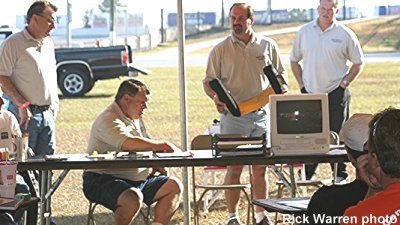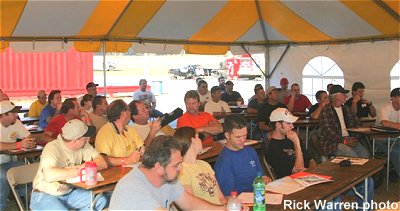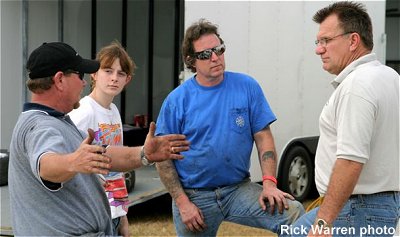| Students Say Wayne Anderson’s First Racing School a Big Success | By Rick Warren
-KARNAC.com
What do racers do during the off season? Some build new race cars. Some rebuild old race cars. Some go hunting. Some catch up on chores that were put off during the long racing season. Some however, this year, decided to go to school.
Racing School! Not just any racing school, but a school held by 3 of the winningest racers in the state of Florida.

Wayne Anderson, Lee Faulk, and Dick Anderson were on hand to not only talk about winning, but to share the knowledge they have gained over years of racing and winning.
Mike Howell, himself a former racer, and vice president/director of the school, explained the school was designed for the serious racer. It was intended to take the racer, starting with basics, and rapidly moving into hands on setup, and showing the racer how to get the absolute most from their race car. The final day would include track time on the asphalt of Ocala Speedway, to put the newly gained knowledge to the test.
With over 50 students in attendance, everyone stayed very busy, especially the instructors and their assistants. Racers traveled from as far away as Arkansas, Pennsylvania and Georgia to learn more about how to make their racers go faster.
As local racer Jeremy Gerstner described it, “I’m here looking for that edge. If I can spend a weekend and pick up a couple tenths on the track, it’s time well spent.” Another racer put it this way; “I’ve followed behind the Andersons on the track more than once. I’d like to race with them. I want to find some of the Anderson Magic”.
Day One
The quest for the ”Anderson Magic” began Friday morning. After a Meet and Greet session, it was on to the classroom for some serious learning. Presentations were made by all three instructors, concerning definition of terms, relationship of chassis parts, ( i.e. why does changing the location of the panhard bar affect the way the front of the car works? ), and typical race preparation.
Presentations were also made by representatives from various manufacturers of racing hardware. These presentations by the manufacturers were not designed to sell specific products, but to inform the racers of the best methods of using the racing equipment, and how to select the right part for each specific application.
Dan O’Connell, a very successful race engine builder, talked about getting the most power and durability from an engine. Dan discussed proper methods of measuring valve lash, what exactly a compression test will let you about your engine, and how carburetor / spacer plate / intake manifold combinations affect total output and best operating RPM of a racing engine.
Mike Newcomb of ARP racing bodies was on hand to discuss what is available in the world of race car bodies. He explained proper mounting techniques, and how placement of the body can affect the handling characteristics of a race car.
Gaylord Rowe had several examples of the latest safety equipment on display, and explained pros and cons of the different safety devices that are currently available. As he talked about safety, Mr. Rowe, of R & R Solutions, and also a representative of Safety Solutions / Bill Simpson Racing, had all the students’ undivided attention.
Also present were Trent Thomasson and Steve Hood, of Essex Parts Services, manufacturers of AP Brake Products. Mr. Hood is a product engineer with the parent company in England, and Mr. Thomasson is a product manager from North Carolina.
In his presentation, Thomasson explained in depth the importance of attention to detail, and brake system maintenance, to keep good brakes on a race car for the entire race. Thomasson and Hood also discussed the different brake fluids available for racing applications, and pros and cons of the various fluids.
Walt Stanley of PRO Shocks discussed various shock packages, what to do to keep expenses down in the shock absorber department. Stanley also explained techniques to insure long life for shocks. Stanley also explained different terms in “shock language”, and how to use shocks to fine tune a race car chassis.
All during the days classroom activities, questions from the students were welcomed and encouraged. As you might imagine, all the students had a multitude of questions for all the manufacturers representatives, and the reps all did an excellent job of answering the questions. At the end of the day, all the students agreed that this was a very beneficial day. Jeremy Gerstner, Ocala Speedway 2003 Modified Champion, remarked that he had attended several racing schools, and added, “ I got more useful information today than all the other schools combined”.
Day Two
Day 2 dawned bright and sunny, and very warm for this time of year. As the pit area where the racers had their cars set up came to life, it looked almost like a race day. Any student without a car was assigned to one of the teams with a car. All the racers went to work on the cars, putting into practice the knowledge they had gained the day before in the classroom.

Class books full of notes were in use everywhere you looked, and the instructors were busier than a cows tail in fly season. At any time you might see an instructor under a car helping to square the chassis, or at the tech shed showing the correct way to rate a spring, or leaning under a fender helping to square a brake caliper, or demonstrating the easiest way to measure and adjust bump steer.
All day , while the students were literally rebuilding their racers, with help from the instructors, the manufacturers reps were just as busy, giving advice, and even turning the occasional wrench. One racer was heard to say that he hoped the Speedway didn’t charge him for filling the dumpster with his no longer needed parts! As the day went on, all the cars were nearing readiness for the test and tune session to come on day 3.
Chris Turner, a Late Model driver from Naples, Fl.told us how good it was to have the car right there, so that He and his crew could make some immediate practical applications of the tips they had picked up in the classroom.
Young Ryan Forstner, 16 years old, all the way from Arkansas, and fresh from running the Snow Flake Derby at Five Flags Speedway in Pensacola, talked about how much he had learned about the chassis, and how he felt it would help him to better communicate what the car was doing on the track to his crew chief, (his father).
Another young racer, Jackie Ziegler, 13, from Pennsylvania explained that coming from open wheel racing, the full bodied cars were a new experience for her, and the knowledge gained would really help her hit the track running. As her ambition is to work her way into the Busch ranks, and eventually into Nextel Cup, she felt that this experience was invaluable to her.
Nobody in the work area worked any harder than this young lady, and any who got to know her will not be surprised if someday they see her name in the ranks of Nascar.

Tal Ethridge, from Georgia, an experienced racer, and his crew, seemed to be thoroughly enjoying the day, and doing a tremendous amount of work on their bright yellow racer. Tal was heard to say that the best part of the school so far was learning that there were easier ways to do things in setting up a race car chassis. By the end of day 2, all the students were learning that “finding the edge”, or “getting some magic”, could be done, but involved a great deal of work.
Day Three
The Payoff for all the hard work. This was the time to see what all the hard work had accomplished. The day started with the instructors speaking on actual driving techniques. Early apex, Late apex, what it means, what it does, what situation for each.
The instructors took the students around the track, describing best lines, where to brake, and why. They talked about passing, where best to accomplish it, and where it was probably not a wise move. As the drivers hit the track, it was plain to see that all had paid great attention to the lessons.
As the day progressed, drivers gained confidence, got used to new set ups, lap times got quicker, and adjustments were made. The drivers all got experience and understanding as to what changes affect what on their race car. You could see the drivers and crew members smiling as all the pieces of the newly gained knowledge started to fit together.
The key to the puzzle of the consistently quick race car was coming to completion for these dedicated racers. At the end of the day, all those who experienced this racing school agreed, that it was time very well spent.
Many expressed plans to return next year, and others say they will recommend the school to any serious racer who wants to stay on top of the game. And who knows, perhaps some of them, if not all , found the “magic” that they were looking for.
PHOTO GALLERY AVAILABLE HERE
-Rick Warren
[Rick Warren is the Media Representative for Bronson Motor Speedway and a regular photo contributor to KARNAC.com]
Have an opinion on this story? Post a message on our Message Board!
or send a letter to the editor!
|

